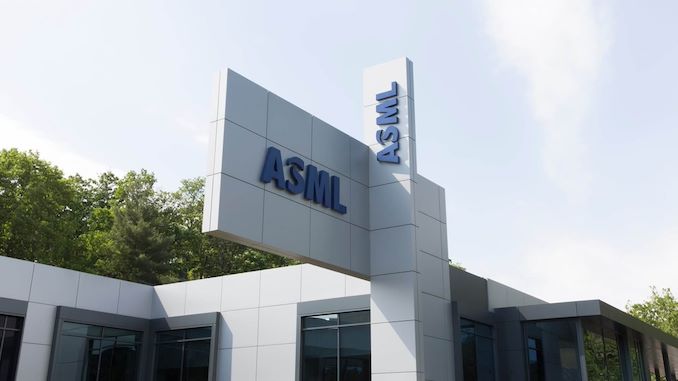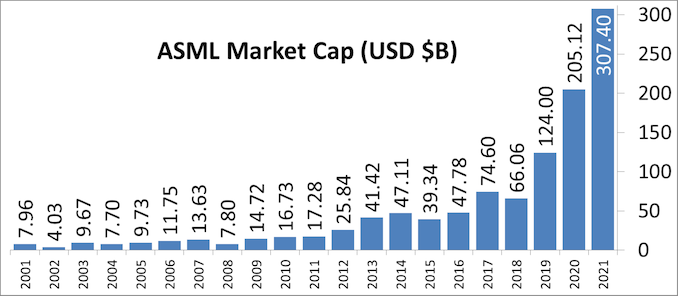Intel's Process Roadmap to 2025: with 4nm, 3nm, 20A and 18A?!
by Dr. Ian Cutress on July 26, 2021 5:00 PM ESTSidebar on Intel EUV
In all of these announcements, one thing to highlight is Intel mentioning its relationship with ASML, the sole company that manufactures the EUV machines powering production of leading edge semiconductor manufacturing.
ASML is a unique company in that it is the only one that can produce these machines, because the technology behind them is often tied up with its partners and research, but also because all the major silicon manufacturers are heavily invested in ASML. For any other company to compete against ASML would require building a separate network of expertise, a decade of innovation and design, and a lot of capital. None of the major silicon vendors want to disturb this balance and go off on their own, lest it shuts them out of the latest manufacturing technology, and no research fund sees competing against the embedded norm as a viable opportunity. This means that anyone wanting EUV specialist technology has to go to ASML.
In 2012, it was reported that Intel, Samsung, and TSMC all invested in ASML. This was, at the time, to jumpstart EUV development along with migrating from 300mm wafers to 450mm wafers. While we haven’t moved to 450mm wafers yet (and there are doubts we will any time in the next decade), EUV is now here. Intel’s 2012 investment of $2.1 billion gave them a 10% stake in ASML, with Intel stating that it would continue investing up to a 25% stack. Those stakes are now below the 5% reporting threshold, but all three of the major foundry customers are still big owners, especially as ASML’s market cap has risen from $24 Billion in 2012 to $268 Billion in 2021 (surpassing Intel).
As major investors but also ASML’s customers, the race has been on for these foundries to acquire enough EUV machines to meet demand. TSMC reported in August 2020 that it has 50% of all EUV machines manufactured at ASML for its leading edge processes. Intel is a little behind, especially as none of Intel’s products in the market yet use any EUV. EUV will only intercept Intel’s portfolio with its new Intel 4 process, where it will be used extensively, mostly on the BEOL. But Intel still has to order machines when they need them, especially as there are reports that ASML currently has backorders of 50 EUV machines. In 2021, ASML is expected to manufacture around 45-50 machines, and 50-60 in 2022. The exact number of machines Intel has right now, or has ordered from ASML, is unknown. It is expected that each one has a ~$150m price tag, and can take 4-6 months to install.
With all that being said, Intel’s discussion point today is that it will be the lead customer for ASML’s next generation EUV technology known as High-NA EUV. NA in this context relates to the ‘numerical aperture’ of the EUV machine, or to put simply, how wide you can make the EUV beam inside the machine before it hits the wafer. The wider the beam before you hit the wafer, the more intense it can be when it hits the wafer, which increases how accurately the lines are printed. Normally in lithography to get better printed lines, we move from single patterning to double patterning (or quad patterning) to get that effect, which decreases yield. The move to High-NA would mean that the ecosystem can stay on single patterning for longer, which some have quoted as allowing the industry to ‘stay aligned with Moore’s Law longer’.
| ASML's EUV Shipments | |||||||||||||||||||||
| 2015 | 2016 | 2017 | 2018 | 2019 | 2020 | 2021 | |||||||||||||||
| Actual | 2 | 4 | 10 | 3 | 4 | 5 | 6 | 4 | 7 | 7 | 8 | 4 | 7 | 14 | 8 | 7 | 9 | - | - | ||
| Target (Total) | - | - | - | 20 (18) | 30 (26) | 35 (33) | 45-50 | ||||||||||||||
| 2018 and beyond is split per quarter for actual shipped numbers Data taken from ASML's Financial Reports |
|||||||||||||||||||||
Current EUV systems are NA 0.33, while the new systems are NA 0.55. ASML’s latest update suggests that it expects customers to be using High-NA for production in 2025/2026, which means that Intel is likely going to be getting the first machine (ASML NXE:5000 we think) in mid-2024. Exactly how many High-NA machines ASML intends to produce in that time frame is unknown, as if they flood the market, having the first won’t be a big win. However if there is a slow High-NA ramp, it will be up to Intel to capitalize on its advantage.













326 Comments
View All Comments
Spunjji - Thursday, July 29, 2021 - link
Then someone might expect them to actually release a product approaching that density 😬arashi - Monday, July 26, 2021 - link
Especially when Intel has failed to ship anything remotely close to the peak density while TSMC is. Ian has lost credibility with his hype-boy-isms in this article.arashi - Monday, July 26, 2021 - link
Just compare the wording to the sponsored posts. I don't see a difference.mode_13h - Monday, July 26, 2021 - link
That's because the article is reporting on their press conference. So, all they're doing it taking the Intel-provided slides and commentary and making it more accessible for us plebs.Where I think you could legitimately say Ian has a bit of Stockholm Syndrome is in his lobbying for "industry standard naming". I think it's crossing the line, as journalist, to do anything more than ask his interviewees questions about this confusion.
Oxford Guy - Wednesday, July 28, 2021 - link
You really believe that — that journalists are stenographers?Finding one who is actually independent (since media is owned by the wealthy) is like trying to find citizens of Atlantis. (Also, even with a valiant attempt at true objectivity we’re all products of culture as well as genetic biases — aka personality.)
However, there is a some range in journalism between the stenographer for corporate/plutocratic marketing and someone who has an advanced/terminal degree in the field being covered. The latter can, at least, make the effort to have a dialogue rather than passively listening to monologue and regurgitating it on cue.
mode_13h - Thursday, July 29, 2021 - link
> You really believe that — that journalists are stenographers?No, of course not. They can & should add context and critical analysis. I think the article does some of that, but it's primarily concerned with conveying and explaining Intel's message.
I was simply trying to explain why it reads like a press release. It's hard to faithfully cover a press event and *not* have it sound somewhat like that.
Oxford Guy - Wednesday, August 11, 2021 - link
‘No, of course not. They can & should add context and critical analysis’Don’t contradict what you said before in this very topic or anything.
‘I was simply trying to explain why it reads like a press release.’
You could have said that rather than what you did say.
mode_13h - Thursday, August 12, 2021 - link
> Don’t contradict what you said beforeIt's not. It's a clarification. My position on this issue hasn't changed, so any apparent contradiction is probably a case of misinterpretation or where I was being too terse. I generally try to keep my comments short and to-the-point, sometimes to a fault.
ikjadoon - Monday, July 26, 2021 - link
OK, wild, what?TSMC & Samsung have been doing this for *years*: blatantly misleading people. There is no "TSMC 12nm" nor a "TSMC 6nm" nor a "TSMC 4nm". These are not actually genuinely noticeable peak density increases versus 16nm, 7nm, nor 5nm.
nandnandnand - Tuesday, July 27, 2021 - link
>These are not actually genuinely noticeable peak density increases versus 16nm, 7nm, nor 5nm.Well that's not true. TSMC 6nm is 18% more dense than TSMC 7nm, which is more than what a 6/7=0.857... calculation would imply.